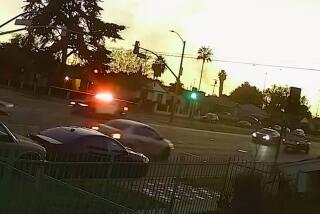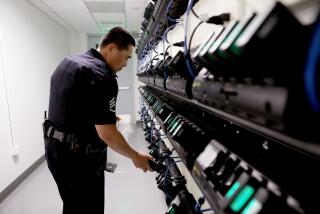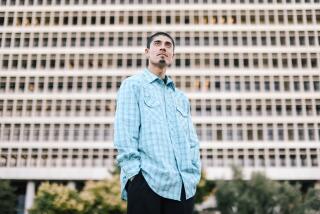Chicago police shooting video release reflects change in policy, not policing
Reporting from Chicago — As Chicago officials continue to try to repair the political damage and distrust sown by past police abuses, disturbing new video emerged Friday that illustrates how much has changed in recent months and how much has not.
On one hand, city officials acted with uncharacteristic speed to release video of the fatal shooting of Paul O’Neal, an African American 18-year-old who crashed into police vehicles in a stolen Jaguar convertible July 28. Breaking with long-standing practice, police Superintendent Eddie Johnson almost immediately revoked the police powers of the three officers who fired shots, saying it appeared they’d violated policy.
But the videos the city released indicated in painfully clear detail that issues that have plagued the department — including insufficient training and tactical blunders leading to questionable uses of force — remain unresolved.
Departmental policy specifically bans shooting at a car when it is the lone threat, but the videos show that officers fired about 15 shots at the fleeing Jaguar on a leafy, typically quiet South Shore block before the sports car plowed into a police SUV down the street. Other officers appeared to be directly in the line of fire when police shot at the fleeing vehicle.
After O’Neal ran from the Jaguar, police chased him into a backyard, firing about five more shots and then handcuffing him as he lay dying. O’Neal, who was unarmed, died of a gunshot wound to the back, authorities have said.
Although the body camera of the officer who fired at O’Neal in the yard was not recording — for unexplained reasons — as he fired the shots, it was turned on after the shootings, raising questions as to how well officers on the street know how to work the newly introduced cameras. The devices the officers wore nonetheless captured potentially damning comments afterward.
The officer who fired his gun in the backyard said he thought O’Neal might have been shooting at him from the speeding Jaguar, when in fact his colleagues had been firing on the car.
That officer also said that when he opened fire on O’Neal, “I didn’t know if he was armed or not.”
The shooting and response represent a test of a city and a department in the early stages of a reform effort sparked by the release eight months ago of video of a white officer shooting black teenager Laquan McDonald 16 times. The U.S. Justice Department is investigating whether the department has systematically violated citizens’ rights, and Mayor Rahm Emanuel has introduced a raft of reforms aimed at getting in front of any potential federally enforced changes.
The video’s release is likely to mark only the start of the fallout over the incident. Activists shouted down Johnson as he tried to speak outside police headquarters Friday, and more protests were promised. A police spokesman said the agency would take a “hard look” at the training and tactics at play in the incident.
Attorney Michael Oppenheimer, who has sued the department on behalf of O’Neal’s family, called the footage “beyond horrific” and said he plans to call for a special prosecutor to look into the shooting.
“There is no question in my mind that criminal acts were committed,” said Oppenheimer, a former prosecutor. “What I saw was pretty coldblooded.”
Prosecutors have yet to review the case, a spokeswoman for the Cook County State’s Attorney’s Office said, as the department and the Independent Police Review Authority gather evidence. IPRA, frequently criticized for cursory investigations that have almost always cleared officers, is also under new leadership and has proved more willing recently to rule that police violated policy in shootings, particularly in cases involving officers firing into cars.
Emanuel said in a statement that Johnson’s quick move to strip the officers’ police powers after the shooting “underscores the fundamental change in how the city handles police shootings.”
The three officers — who have not been publicly identified — are to remain stripped of their authority pending the investigations, officials said.
Dean Angelo Sr., president of the Fraternal Order of Police Chicago Lodge 7, said in a statement that people should consider how quickly the incident unfolded before judging the officers.
“While this case remains fluid in nature, it is of critical importance to every Chicagoan to not rush to judgment and to allow the systems in place to play out,” he said.

Shooting victim Paul O’Neal’s sister Briana Adams, 22, briefs the news media Aug. 5, 2016, along with attorney Michael Oppenheimer and activist Ja’Mal Green. The family viewed police videos from the shooting death of O’Neal earlier in the day at IPR
O’Neal’s sister Briana Adams, 22, tearfully told reporters her family found the videos devastating. She said her brother had graduated from high school and wanted to go to trade school and perhaps work for ComEd.
“We was really hurt,” Adams said. “We just want answers — the truth.”
The wide introduction of body cameras was a main element of Emanuel’s proposal to reform the department, and a key question remained after the release of the video: Why wasn’t the camera attached to the officer who shot at O’Neal in the yard operating during the shooting, when it was somehow activated afterward?
The matter remains under investigation, and the camera was either affected by the crash or not turned on by the officer, Police Department spokesman Frank Giancamilli said. The officers had received the cameras no more than 10 days before the shooting, Giancamilli said, and did not have much time to familiarize themselves with the gear. “User error” might have been a factor, he said.
Another question facing the department is why the officers shot at a fleeing vehicle. The department revised its rules on shooting into vehicles in February 2015, and the policy specifically bans officers from shooting at a car when a car is the only danger.
Asked whether officers are trained on the rules about shooting into cars, Giancamilli said Johnson had asked his command staff to examine training, tactics and national best practices relevant to the incident “to determine how we can best equip our officers to best serve the people of the city.”
The nine clips from dashboard and body cameras — clear, loud and harrowing — show what happened as O’Neal drove up to police about 7:30 p.m. July 28 in the 7400 block of South Merrill Avenue. The Jaguar he was driving was reported stolen in suburban Bolingbrook, and officials there said video tied O’Neal and other men to a series of car thefts.
The video clips show the Jaguar rolling toward a police SUV, passing between the SUV and a parked car, striking one of the vehicles. One officer — his gun drawn while still in his vehicle — jumps out of the passenger side of the SUV and opens fire on the Jaguar as it moves past.
The officer sprays bullets from his handgun, striking his own vehicle at least once and appearing to come close to hitting another officer standing across the street. As the Jaguar moves into the distance, both officers fire. The officers fire about 15 shots in about five seconds, and they are firing in the direction of another police SUV down the street.
The video shows O’Neal’s flight in the Jaguar ending as he barrels head-on into a police SUV. After that, an officer can be heard yelling, “Emergency, emergency, let me see your … hands, hands up!”
The clips show that O’Neal ran from the car after it hit the SUV, and officers from that vehicle ran after him, with the officers who had fired on the Jaguar following behind. About 20 seconds after the crash, five shots can be heard on the body cameras worn by officers other than the shooter.
While the videos include extensive footage filmed before and after the incident, less than a minute elapses between the first collision and police shooting at O’Neal in the backyard.
In the aftermath, the video shows officers crowding around the collapsed O’Neal, his back and shirt soaked in blood. As police handcuff O’Neal, an officer can be heard saying, “… shoot at us.”
The footage caught the officers talking after the shooting, and their comments capture the confusion over what happened and their concern over their justification for the shooting.
The officer who shot at the Jaguar as it sped away was recorded saying to another officer, “I shot at the car after it almost hit you.”
“… man, I’m going to be on the desk for 30 goddamn days now,” he says.
Footage from the officer who said he believed he shot O’Neal in the yard indicated that he thought the shots he heard during the vehicle pursuit were coming from the Jaguar as it sped at him. He acknowledged to another officer that he fired without knowing if O’Neal had a weapon.
Later, that officer suggested O’Neal was armed, though police found he was not, the video shows.
“Dude, I heard shots. I don’t ... know, man. When he came out the yard, he shot at me,” the officer said.
The officers’ reactions to the shooting disturbed representatives of O’Neal’s family.
Oppenheimer, the family’s lawyer, said, “They did everything but high-five each other.”
He said the videos expose the need to improve officer training.
“This goes down to training on race, this goes down to training on the community,” Oppenheimer said. “There’s a lot that needs to be done. Some of it has been done. We have a long way to go.”
Chicago Tribune’s Jeff Coen, William Lee, Steve Schmadeke, Annie Sweeney and Jennifer Smith Richards contributed to this report.
MORE FROM NATION
How these Brooklyn prosecutors work to get convicts out of prison
Here’s what happened to the sites of past mass shootings
Was this former U.S. soldier an aspiring terrorist, or was he set up by the FBI?
More to Read
Sign up for Essential California
The most important California stories and recommendations in your inbox every morning.
You may occasionally receive promotional content from the Los Angeles Times.










